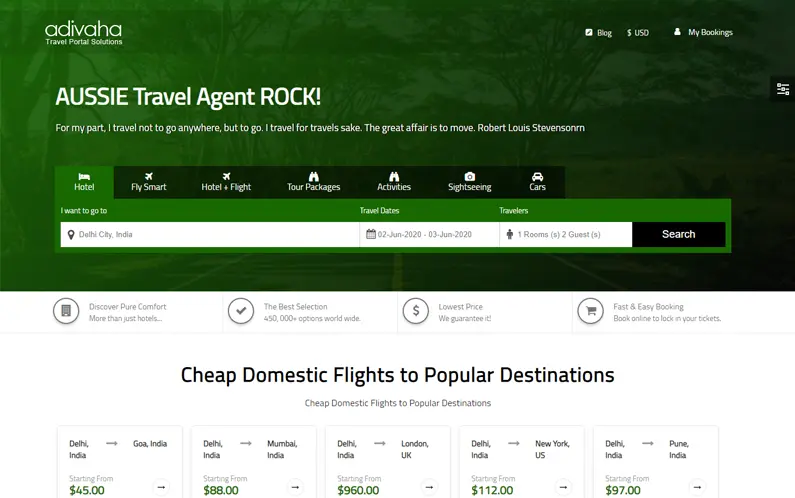Ready to go-LIVE travel solutions that helps your travel agency to sell a range of travel services pretty instantly. adivaha® travel solutions make sure you have no boundation over your imagination, you can do everything online, without the need for any technical knowledge or design skills. Easy Backoffice, extensive reporting with integrated Funds Management System.
WordPress Plugin API Revolutionizes Web Development Landscape
The Plugin API in WordPress is a powerful feature that allows developers to extend the functionality of their websites. When it comes to creating plugins for WordPress, the plugin API plays a crucial role in facilitating interaction between the plugin and the WordPress core. For instance, when developing a plugin hotel booking WordPress, developers can leverage the plugin API to integrate various features seamlessly. By utilizing the plugin API in WordPress, developers can ensure that their plugins are efficient, secure, and compatible with the latest WordPress updates.
Creating a plugin hotel wordpress can be simplified with the capabilities of the plugin API in WordPress. With the plugin API, developers can hook into different actions and filters provided by WordPress, enabling them to customize various aspects of their plugins. When developing a plugin hotel WordPress, developers can utilize the plugin API to integrate essential features such as online booking systems, room availability calendars, and payment gateways. By harnessing the power of the plugin API in WordPress, developers can create robust and user-friendly hotel booking plugins that cater to the specific needs of hotel owners and their customers.
In conclusion, the plugin API in WordPress serves as a cornerstone for developing feature-rich plugins, including plugin hotel booking wordpress and plugin hotel WordPress. By understanding and leveraging the capabilities of the plugin API, developers can create plugins that enhance the functionality and usability of WordPress websites. Whether you are building a booking system for a hotel website or adding new features to a hospitality site, the plugin API in WordPress provides the tools and flexibility needed to bring your ideas to life.
Are you looking to streamline your booking process on your WordPress website? A plugin reservation wordpress can be the perfect solution for you. With a plugin reservation WordPress, you can efficiently manage all your reservations in one place, ensuring a hassle-free booking experience for your customers. Whether you run a hotel, a restaurant, or any other business that requires reservations, this plugin is a must-have to enhance your online booking system.
For those in the travel industry, a plugin travel wordpress is a game-changer. This plugin offers a wide range of features designed specifically for businesses in the travel sector. From managing tour bookings to handling accommodation reservations, a plugin travel WordPress simplifies the entire booking process. With features like availability calendars, customizable booking forms, and seamless payment integration, this plugin is essential for any travel website looking to provide a smooth reservation experience for their customers.
If you're looking to boost your revenue through affiliate marketing, a plugin wordpress affiliate can help you achieve your goals. This plugin allows you to easily set up an affiliate program on your WordPress site, enabling you to drive traffic and sales through affiliate links. With features like real-time tracking, commission management, and customizable affiliate dashboards, a plugin WordPress affiliate empowers you to effectively manage your affiliate marketing efforts. Whether you're a blogger, an e-commerce store owner, or a service provider, this plugin is a powerful tool to maximize your affiliate marketing potential.
The WordPress Plugin API has significantly transformed the way websites are developed, offering developers a streamlined method to enhance functionalities. When it comes to plugin reservation WordPress, this API enables seamless integration of booking systems, allowing businesses to efficiently manage their schedules and appointments through user-friendly interfaces. This level of customization enhances user experience and boosts operational efficiency for various industries relying on reservations.
Travel websites can leverage the power of plugins to offer comprehensive services to their visitors. The plugin travel WordPress segment has witnessed a surge in innovative solutions due to the WordPress Plugin API, making it easier for travel businesses to showcase destinations, manage bookings, and provide real-time information to customers. Whether it's organizing trips, facilitating accommodations, or promoting travel packages, the versatility of WordPress plugins in the travel industry is revolutionizing online booking experiences.
Affiliate marketing through WordPress has become more dynamic with the advent of plugin WordPress affiliate capabilities. Integrating affiliate programs seamlessly into websites has never been more straightforward, empowering businesses to monetize their content effectively. By utilizing plugins tailored for affiliate marketing, WordPress users can track referrals, manage commission payouts, and optimize their affiliate strategies to drive revenue growth. The expansion of affiliate plugin options demonstrates how the WordPress Plugin API is reshaping the digital marketing landscape.
Keep Refreshing your customers - Who doesn't want his site to stand out from crowd? adivaha® gives you multiple options for home pages, headers, colors etc. Which can easily be managed from admin via shortcodes and settings. The theme supports almost all the big players in this market ie, WEGO, Travelpayouts, Agoda, Booking, Expedia etc.












